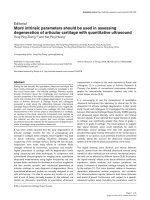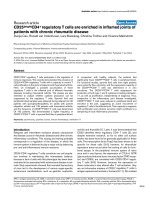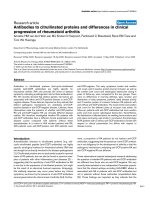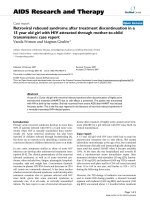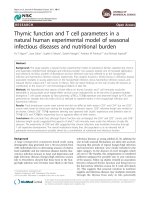Báo cáo y học: " Myoglobin clearance by super high-flux hemofiltration in a case of severe rhabdomyolysis: a case report" doc
Bạn đang xem bản rút gọn của tài liệu. Xem và tải ngay bản đầy đủ của tài liệu tại đây (444.63 KB, 6 trang )
Open Access
Available online />R90
April 2005 Vol 9 No 2
Research
Myoglobin clearance by super high-flux hemofiltration in a case of
severe rhabdomyolysis: a case report
Toshio Naka
1
, Daryl Jones
2
, Ian Baldwin
3
, Nigel Fealy
4
, Samantha Bates
5
, Hermann Goehl
6
,
Stanislao Morgera
7
, Hans H Neumayer
8
and Rinaldo Bellomo
9
1
Research Fellow, Department of Intensive Care and Department of Medicine, Melbourne University, Austin Hospital, Melbourne, Australia
2
Registrar, Department of Intensive Care and Department of Medicine, Melbourne University, Austin Hospital, Melbourne, Australia
3
Nurse Educator, Department of Intensive Care and Department of Medicine, Melbourne University, Austin Hospital, Melbourne, Australia and PhD
Candidate, Latrobe University, Bundoora, Melbourne, Australia
4
Nurse Educator, Department of Intensive Care and Department of Medicine, Melbourne University, Austin Hospital, Melbourne, Australia
5
Research Nurse, Department of Intensive Care and Department of Medicine, Melbourne University, Austin Hospital, Melbourne, Australia
6
Chief Engineer, Gambro Dialysatoren GmbH & Co., KG, Hechingen, Germany
7
Staff Specialist, Department of Nephrology, Charitè, Humboldt, University of Berlin, Germany
8
Director, Department of Nephrology, Charitè, Humboldt, University of Berlin, Germany
9
Director of Research, Department of Intensive Care and Department of Medicine, Melbourne University, Austin Hospital, Melbourne, Australia
Corresponding author: Rinaldo Bellomo,
Abstract
Objective To test the ability of a novel super high-flux (SHF) membrane with a larger pore size to clear
myoglobin from serum.
Setting The intensive care unit of a university teaching hospital.
Subject A patient with serotonin syndrome complicated by severe rhabodomyolysis and oliguric acute
renal failure
Method Initially continuous veno-venous hemofiltration was performed at 2 l/hour ultrafiltration (UF)
with a standard polysulphone 1.4 m
2
membrane (cutoff point, 20 kDa), followed by continuous veno-
venous hemofiltration with a SHF membrane (cutoff point, 100 kDa) at 2 l/hour UF, then at 3 l/hour UF
and then at 4 l/hour UF, in an attempt to clear myoglobin.
Results The myoglobin concentration in the ultrafiltrate at 2 l/hour exchange was at least five times
greater with the SHF membrane than with the conventional membrane (>100,000 µg/l versus 23,003
µg/l). The sieving coefficients with the SHF membrane at 3 l/hour UF and 4 l/hour UF were 72.2% and
68.8%, respectively. The amount of myoglobin removed with the conventional membrane was 1.1 g/
day compared with 4.4–5.1 g/day for the SHF membrane. The SHF membrane achieved a clearance
of up to 56.4 l/day, and achieved a reduction in serum myoglobin concentration from >100,000 µg/l
to 16,542 µg/l in 48 hours.
Conclusions SHF hemofiltration achieved a much greater clearance of myoglobin than conventional
hemofiltration, and it may provide a potential modality for the treatment of myoglobinuric acute renal
failure.
Introduction
Rhabdomyolysis and myoglobinuria are responsible for
approximately 5% of all causes of acute renal failure (ARF) in
the USA [1]. The cause of rhabdomyolysis is often multifacto-
rial [2], and approximately 8–20% of such patients develop
myoglobinuric ARF [3]. The myoglobin released during rhab-
domyolysis is thought to cause renal dysfunction by producing
renal tubular obstruction, lipid peroxidation within the tubular
Received: 4 October 2004
Revisions requested: 15 November 2004
Revisions received: 25 November 2004
Accepted: 1 December 2004
Published: 21 January 2005
Critical Care 2005, 9:R90-R95 (DOI 10.1186/cc3034)
This article is online at: />© 2005 Naka et al., licensee BioMed Central Ltd.
This is an Open Access article distributed under the terms of the
Creative Commons Attribution License ( />licenses/by/2.0), which permits unrestricted use, distribution, and
reproduction in any medium, provided the original work is properly
cited.
ARF = acute renal failure; CVVH = continuous veno-venous hemofiltration; SC = sieving coefficient; SHF = super high-flux; UF = ultrafiltration.
Critical Care April 2005 Vol 9 No 2 Naka et al.
R91
cells, and renal vasoconstriction [1]. Intravascular volume
expansion, urinary alkalinization, and forced diuresis are cur-
rently used as renal-protective measures [4]. These treatments
are not useful in the context of severe oliguria, and may also
cause pulmonary edema. In the setting of oliguria, removal of
myoglobin using blood purification techniques may be
advantageous.
Previous attempts to remove myoglobin using plasma
exchange [5,6], intermittent hemodialysis [7], and continuous
renal replacement therapies have unfortunately met with lim-
ited success [6-11].
We have recently described a novel super high-flux (SHF)
membrane with a pore cutoff size of 100 kDa, which has the
ability to dialyze inflammatory cytokines and β
2
-microglobulin
[12-15]. We now describe the use of SHF hemofiltration in a
patient with severe rhabdomyolysis and oliguric ARF second-
ary to serotonin syndrome, and report on the kinetics of
myoglobin clearance using both conventional and SHF
hemofiltration.
Case report
A 53-year-old female presented with complications of a polyp-
harmacy overdose. Her past medical history included depres-
sion, hyperlipidemia, and anorexia nervosa. There was a
previous history of amphetamine abuse as well as two prior
episodes of polypharmacy overdose. The patient was discov-
ered at home with a Glasgow Coma Score of 11 and was
noted to be hypotensive and tachycardic. Soon after transfer
to hospital, the patient became unconscious (Glasgow Coma
Score, 3) and was intubated. Empty bottles of paroxetine,
moclobemide, pravastatin, and alprazolam were found in her
house. The patient was not known to be on neuroleptic antip-
sychotic medications, and had not used amphetamine for at
least 1 year.
The patient subsequently developed features of serotonin syn-
drome [16,17], with progressive hypotension despite a central
venous pressure of 10 mmHg and commencement of nore-
pinephrine to a maximum dose of 2.5 µg/kg/min, as well as 10
l fluid resuscitation on the first day of admission. Additional
features of serotonin syndrome included fever (42°C) and
generalized hypertonicity, which was complicated by severe
rhabdomyolyis (peak creatine kinase level, 109,000 IU/l). Fur-
thermore, there was evidence of coagulopathy, with severe
bleeding from puncture sites and the gastrointestinal tract.
Investigations confirmed the presence of disseminated intra-
vascular coagulopathy.
The patient developed profound metabolic derangement with
lactic acidemia (lactate peak, 11.7 mmol/l; pH nadir, 7.14),
oliguric ARF, severe hyperkalemia (K
+
, 9.1 mmol/l at presenta-
tion), hypocalcemia, hyperphosphatemia, and hypomag-
nesemia, and with the subsequent development of ischemic
hepatitis (alanine aminotransferase, 4048 U/l; alkaline phos-
phatase, 92 U/l). On the first intensive care unit day, continu-
ous veno-venous hemofiltration (CVVH) with a conventional
hemofilter was employed for the management of oliguric ARF
and hyperkalemia.
Treatment with fresh frozen plasma, cryoprecipitate, platelet
and red blood cells was required. Specific treatment of serot-
onin syndrome was based on therapies described elsewhere
[16,17], and included active cooling, cyproheptadine, a mida-
zolam infusion, and neuromuscular blockade with vecuronium.
Conventional CVVH and SHF CVVH
A 13 Fr dual-lumen catheter (Niagara, Bard, Toronto, Canada)
was inserted into a femoral vein and CVVH was performed
using a Kimal Hygieia Plus machine (Medtel, Perth, Australia).
The blood flow was set at 200 ml/min and the ultrafiltration
(UF) rate was set at 2 l/hour. A bicarbonate-based commercial
replacement fluid (Hemosol; Gambro, Sydney, Australia) was
administered at the pre-filter site. Initially a polysulphone 1.4
m
2
membrane (molecular cutoff, 20 kDa) (APS; ASAHI-medi-
cal, Tokyo, Japan) was used for conventional CVVH. On the
following day, the hemofilter was changed to a novel SHF
Table 1
Sieving coefficient and clearance of myoglobin using conventional and super high-flux (SHF) continuous veno-venous
hemofiltration in a patient with severe rhabdomyolysis secondary to serotonin syndrome
Filter type Ultrafiltration rate
(l/hour)
Myoglobin concentration (µg/l) Sieving coefficient
(%)
Myoglobin removal
(g/day)
Myoglobin
clearance (ml/min)
Pre-filter Post-filter Ultrafiltrate
Conventional
(polysulphone)
2 >100,000 >100,000 23003 <0.23 1.1 <8
SHF 2 >100,000 >100,000 >100,000 Unable to
calculate
>4.8 Unable to calculate
SHF 3 100,000 68,776 60,912 0.722 4.4 30.5
SHF 4 91,058 64,587 53,527 0.688 5.1 39.2
Available online />R92
membrane (molecular cutoff point, 100 kDa) (Polyflux P2SH;
Gambro Dialysatoren, Hechingen, Germany). The UF volume
rate was commenced at 2 l/hour and sequentially increased to
4 l/hour over an 8-hour period, before being maintained at 2 l/
hour.
Measurement and calculations
Blood samples were collected at pre-filter and post-filter sites,
and the serum was separated immediately. Ultrafiltrate was
collected simultaneously and all specimens were frozen at -
70°C until measurements were performed. Myoglobin was
measured by a microparticle enzyme immunoassay (AxSYM
system; Abbot Laboratories, Perth, Australia). Using this
AxSYM system assay, the normal lower limit for serum
myoglobin is 150 µg/l and the upper limit of testing is 100,000
µg/l.
The sieving coefficient (SC) was calculated using the formula:
SC = 2C
uf
/(C
pre
+ C
post
), where C
uf
represents the concentra-
tion of myoglobin in the ultrafiltrate, and C
pre
and C
post
are the
pre-filter and post-filter concentrations of myoglobin,
respectively.
The amount of removed myoglobin was calculated as C
uf
× V
uf
,
where C
uf
represents the concentration of myoglobin in the
ultrafiltrate and V
uf
represents the UF volume per unit of time.
The clearance of myoglobin was calculated as C
uf
× V
uf
/C
pre
.
Results
The serum myoglobin concentration was >100,000 µg/l at the
initiation of conventional CVVH, and remained so at com-
mencement of SHF CVVH on the following day (Table 1). The
myoglobin concentration in the ultrafiltrate at 2 l/hour UF
exchange was at least five times greater with the SHF mem-
brane than with the conventional membrane (>100,000 µg/l
versus 23,003 µg/l).
The SCs with SHF hemofiltration at 3 l/hour UF and 4 l/hour
UF exchange rates were 72.2% and 68.8%, respectively,
resulting in the removal of 4.3–5.1 g myoglobin/day and in
myoglobin clearances of up to 56.4 l/day. Treatment with SHF
hemofiltration resulted in a reduction of the serum myoglobin
concentration from >100,000 µg/l to 16,542 µg/l in 48 hours
(Fig. 1). There was a concurrent reduction in the degree of pig-
mentation of the UF fluid over this period (Fig. 2).
Discussion
In the case described in the present study, SHF CVVH
achieved myoglobin clearance values significantly greater than
control treatment with standard high-flux hemofiltration, and
values greater than those previously reported in the literature
[8-11]. Clearance of myoglobin using SHF CVVH was greater
than the total body water over a 24-hour period.
Multiple modalities of renal replacement therapy have been
used in the past in an attempt to clear myoglobin. However,
these modalities have shown limited efficiency [8-11] (Table
2). We have previously presented the results of myoglobin
clearances in three critically ill patients with rhabdomyolysis
treated with continuous hemodiafiltration, which was associ-
ated with a mean daily myoglobin removal of 1.8 g/day with a
myoglobin clearance of 4.6 ml/min [8].
Continuous arterio-venous hemofiltration and CVVH have
been used to investigate myoglobin clearance in a swine
model of myoglobinuric ARF. The use of continuous arterio-
venous hemofiltration and a Hospal AN 69S hemofilter
resulted in myoglobin clearances of 2.05 ± 1.48 l/day, with
410 ± 234 mg myoglobin excreted in the ultrafiltrate over the
6-hour period [9].
CVVH has more recently been used in a single case of
myoglobin-induced renal failure [11]. Using a Hospal AN69
Figure 1
Progressive reduction of serum myoglobin concentration over a 48-hour period using super high-flux (SHF) continuous veno-venous hemo-filtration (CVVH)Progressive reduction of serum myoglobin concentration over a 48-
hour period using super high-flux (SHF) continuous veno-venous hemo-
filtration (CVVH). The serum concentration of myoglobin remained
>100,000 µg/l until commencement of SHF CVVH.
Figure 2
Images of ultrafiltration fluid demonstrating progressive reduction in pigmentation over a 3-day period concurrent with treatment using super high-flux continuous veno-venous hemofiltrationImages of ultrafiltration fluid demonstrating progressive reduction in
pigmentation over a 3-day period concurrent with treatment using
super high-flux continuous veno-venous hemofiltration. ICU, intensive
care unit.
Critical Care April 2005 Vol 9 No 2 Naka et al.
R93
Table 2
Comparison of studies of renal replacement therapy (RRT) in the management of myoglobinuric acute renal failure
Reference Subject(s) Mode of RRT Filter used Sieving coefficient
(%)
Myoglobin removal (g/day) Clearance
(ml/min)
Present study Single patient with ARF due to
rhabdomyolysis
CVVH, 2 l exchange Polysulphone (APS) <0.23 1.1 <8
SHF CVVH, 3–4 l
exchange
Gambro Polyflux P2SH 0.69–0.72 4.3–5.1 30.5–39.2
[8] Three patients with myoglobinuric
ARF
Continuous
hemodiafiltration
Hospal AN 69S 0.21* 1.8 4.6
[9] Swine model of myoglobinuric ARF CAVH Hospal AN 69S 0.15 1.64 (0.41 g/6 hours) 1.42 ± 1.03
[10] Swine model CVVH Hospal AN 69HF 0.36–0.55 2.3–3.8 (0.95 g/6 hours) 11.2–25.2
[11] Single patient with ARF due to
rhabdomyolysis
CVVH Hospal AN69 Multiflow
100
0.40–0.60 1.05 (0.7 g/16 hours) 14–22
[19] Patient with malignant hyperthermia
and rhabdomyolysis
CVVH Gambro polyflux 11S 0.37 4.3 11*
ARF, acute renal failure; CAVH, continuous arterio-venous haemofiltration; CVVH, continuous veno-venous haemofiltration; SHF, super high-flux. *
Calculated from the C
UF
, V
UF
, and C
pre
values provided in these studies
Table 3
Summary of laboratory investigations and blood product administration
Day 1 Day 2 Day 3 Day 4 Day 5
Na
+
144 144 137 131 129
K
+
9.1 4.2 3.9 4.4 4.6
Cl
-
109107989995
HCO
3
20 18 19 19 13
Urea 9 10.3 6.5 4.3 3.7
Creatinine 0.127 0.214 0.111 0.118 0.107
Ca
2+
1.64 1.13 2.3 2.25 2.26
PO
4
2.1 3.22 1.8 1.24 1.6
Albumin 2129322931
Creatine kinase 5199 90,000 71,120 85,426 87,170
Lactate 6.42 9.13 7.37 8.02 13.21
Hemoglobin 106 8.6 82 86 73
White cell count 4.8 5 2 4.7 2.5
Platelets 173 72 31 64 112
International normalized ratio for prothrombin time 1.5 4.6 1.9 3.5 5.4
Activated partial thromboplastin time 32 143 44 64 83
Packed red blood cell units 2 3 0 0 0
Platelets 5 5 5 0 0
Fresh frozen plasma 0 26 2 5 0
Cryoprecipitate 10 14 3 0 0
Albumin (20% solution) (ml) 200 500 100 200 0
Norepinephrine dose (µg/min) 3 6 25 30 100
Available online />R94
Multiflow-100 hemofilter, the SC for myoglobin was reported
at 40–60%. The corresponding clearance of myoglobin over
this period was reported to be up to 22 ml/min (32 l/day).
In the present study, the use of CVVH with a novel SHF hemo-
filter and UF rates of 3–4 l/min was associated with a SC of
69–72% and a clearance of up to 56.4 l/day. This was approx-
imately five times greater than the clearance achieved with
conventional hemofiltration (control) in the same patient.
These results are in keeping with the known difference in the
pore size of the two filters studied (polysulfone cutoff point, 20
kDa versus polyamide cut-off point, 100 kDa) in relation to the
molecular weight of myoglobin (17 kDa), and are also consist-
ent with observations that SHF CVVH can achieve high clear-
ances of other middle molecules such as β
2
-microglobulin and
cytokines [12-15].
Two previous studies utilizing CVVH and high-flux hemofiltra-
tion membranes have documented 24-hour myoglobin clear-
ances of approximately 4.3 g [18,19]. The SC using a Gambro
polyflux 11S membrane was only 37%, however, and neither
of these studies reported on myoglobin clearance or the cutoff
size of the pores of the membrane used.
A potential adverse effect of SHF (high cutoff point) hemofil-
tration is the loss of serum albumin (69 kDa). The SC for albu-
min with SHF hemofiltration has been shown to be at 0.11 at
1 l/hour exchange [12], so that a patient with a plasma albumin
concentration of 20 g/l would be expected to lose 2.2 g/hour
albumin. Over a 24-hour treatment period, this might necessi-
tate albumin replacement using 200 ml of 20% albumin. Our
patient received volume expansion with albumin (100 g over a
24-hour period) as part of her treatment, and her albumin level
increased from 21 to 32 g/l (Table 3) despite SHF hemofiltra-
tion. Nonetheless, there is a possibility for losses of albumin
and, perhaps, for losses of clotting factors or protein-bound
drugs such as fentanyl and midazolam. We thus consider that
monitoring of albumin levels and the clotting status, and
adjustment of the drug dosage might be important when treat-
ing patients with SHF hemofiltration.
Conclusion
The current case offers 'proof of concept' that SHF CVVH can
be employed to clear myoglobin effectively in patients with
rhabdomolysis and ARF. The technique may be of greatest
advantage in patients with oliguric renal failure and in those
already requiring renal replacement therapy. It remains to be
determined whether this technique is capable of altering renal
recovery or mortality in patients with rhabdomyolysis and
myoglobinuria-related ARF.
Competing interests
The author(s) declare that they have no competing interests.
Authors' contributions
TN, DJ, IB, NF, and SB conducted the study and collected the
data, and helped write the paper. HG, SM, HHN, and RB
helped develop and test the membrane, and also helped write
the paper.
References
1. Zager RA: Rhabdomyolysis and myohaemoglobinuric acute
renal failure. Kidney Int 1996, 49:314-326.
2. Knochel JP: Mechanism of rhabdomyolysis. Curr Opin
Rheumatol 1993, 5:725-731.
3. Bywaters EG, Beall D: Crush injuries with impairment of renal
function. Br Med J 1941, 1:427-432.
4. Better OS, Stein JH: Early management of shock and prophy-
laxis of acute renal failure in traumatic rhabdomyolysis. N Engl
J Med 1990, 322:825-829.
5. Kuroda M, Katsuki K, Uehara H, Kita T, Asaka S, Miyazaki R, Aki-
yama T, Tofuku Y, Takeda R: Successful treatment of fulminat-
ing complications associated with extensive rhabdomyolysis
by plasma exchange. Artif Organs 1981, 5:372-378.
6. Cornelissen JJ, Hoanstra W, Haarman HJ, Derksen RH: Plasma
exchange in rhabdomyolysis. Intensive Care Med 1989,
15:528-529.
7. Hart PM, Feinfeld DA, Briscoe AM, Nurse HM, Hotchkiss JL, Thom-
son GE: The effect of renal failure and hemodialysis on serum
and urine myoglobin. Clin Nephrol 1982, 18:141-143.
8. Bellomo R, Daskalakis M, Parkin G, Boyce N: Myoglobin clear-
ance during acute continuous hemodiafiltration. Intensive Care
Med 1991, 17:509.
9. Nicolau DP, Feng YJ, Wu AH, Bernstein SP, Nightingale CH: Eval-
uation of myoglobin clearance during continuous hemofiltra-
tion in a swine model of acute renal failure. Int J Artif Organs
1996, 19:578-581.
10. Nicolau D, Feng YS, Wu AHB, Bernstein SP, Nightingale CH:
Myoglobin clearance during continuous veno-venous hemofil-
tration with or without dialysis. Int J Artif Organs 1998,
21:205-209.
11. Amyot SL, Leblanc M, Thibeault Y, Geadah D, Cardinal J:
Myoglobin clearance and removal during continuous veno-
venous hemofiltration. Intensive Care Med 1999,
25:1169-1172.
12. Uchino S, Bellomo R, Goldsmith D, Davenport P, Cole L, Baldwin
I, Panagiotopoulos S, Tipping P: Super high flux hemofiltration:
a new technique for cytokine removal. Intensive Care Med
2002, 28:651-655.
13. Uchino S, Bellomo R, Morimatsu H, Goldsmith D, Davenport P,
Cole L, Baldwin I, Panagiotopoulos S, Tipping P, Morgera S, et al.:
Cytokine dialysis: an ex vivo study. ASAIO J 2002, 48:650-653.
14. Lee WC, Uchino S, Fealy N, Baldwin I, Panagiotopoulos S, Goehl
H, Morgera S, Neumayer HH, Bellomo R: Beta2-microgrobulin
clearance with super high flux hemodialysis: an ex vivo study.
Int J Artif Organs 2003, 26:723-727.
15. Lee WC, Uchino S, Fealy N, Baldwin I, Panagiotopoulos S, Goehl
H, Morgera S, Neumayer HH, Bellomo R: Super high flux hemo-
dialysis at high dialysate flows: an ex vivo assessment. Int J
Artif Organs 2004, 27:24-28.
16. Martin TG: Serotonin syndrome. Ann Emerg Med 1996,
28:520-526.
17. Mills KC: Serotonin syndrome. A clinical update. Crit Care Clin
1997, 13:763-783.
Key messages
• New super high-flux membranes when used in hemofil-
tration mode can achieve the highest clearances ever
reported for myoglobin and may be useful in patients
with severe rhabdomyolysis
• New super high-flux membranes when used in hemofil-
tration result in some albumin losses. These losses,
however, decrease in time and are not vary large
Critical Care April 2005 Vol 9 No 2 Naka et al.
R95
18. Bastani A, Frenchie D: Significant myoglobin removal during
continuous veno-venous haemofiltration using F80
membrane. Nephrol Dial Transplant 1997, 12:2035-2036.
19. Schenk MR, Beck DH, Nolte M, Wolfgang J: Continuous veno-
venous hemofiltration for the immediate management of mas-
sive rhabdomyolysis after fulminant malignant hyperthermia
in a body builder. Anesthesiology 2001, 94:1139-1141.


